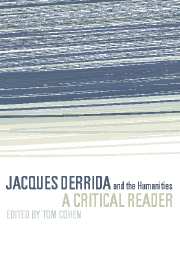Book contents
- Frontmatter
- Contents
- Preface
- Acknowledgements
- Biographical chronology
- Introduction: Derrida and the future of …
- Chapter 1 The future of the profession or the university without condition (thanks to the “Humanities,” what could take place tomorrow)
- Chapter 2 Derrida and literature
- Chapter 3 Derrida and gender: the other sexual difference
- Chapter 4 Derrida and aesthetics: Lemming (reframing the abyss)
- Chapter 5 Derrida and representation: mimesis, presentation, and representation
- Chapter 6 Derrida and philosophy: acts of engagement
- Chapter 7 Derrida and ethics: hospitable thought
- Chapter 8 Derrida and politics
- Chapter 9 Derrida and law: legitimate fictions
- Chapter 10 Derrida and technology: fidelity at the limits of deconstruction and the prosthesis of faith
- Chapter 11 Derrida and history: some questions Derrida pursues in his early writings
- Chapter 12 Derrida and psychoanalysis: desistantial psychoanalysis
- Glossary
- Index
- References
Chapter 5 - Derrida and representation: mimesis, presentation, and representation
Published online by Cambridge University Press: 22 September 2009
- Frontmatter
- Contents
- Preface
- Acknowledgements
- Biographical chronology
- Introduction: Derrida and the future of …
- Chapter 1 The future of the profession or the university without condition (thanks to the “Humanities,” what could take place tomorrow)
- Chapter 2 Derrida and literature
- Chapter 3 Derrida and gender: the other sexual difference
- Chapter 4 Derrida and aesthetics: Lemming (reframing the abyss)
- Chapter 5 Derrida and representation: mimesis, presentation, and representation
- Chapter 6 Derrida and philosophy: acts of engagement
- Chapter 7 Derrida and ethics: hospitable thought
- Chapter 8 Derrida and politics
- Chapter 9 Derrida and law: legitimate fictions
- Chapter 10 Derrida and technology: fidelity at the limits of deconstruction and the prosthesis of faith
- Chapter 11 Derrida and history: some questions Derrida pursues in his early writings
- Chapter 12 Derrida and psychoanalysis: desistantial psychoanalysis
- Glossary
- Index
- References
Summary
The Poet is a powerful magician, creating visions taken for real (the implications of the figure of Prospero in Shakespeare's The Tempest, or Alcandre in Corneille's L'Illusion comique); the Poet is a dangerous liar in society or a hanger-on weaving confidence tricks in the family (Tannegui Lefèvre, 1697; the figure of Trissotin in Molière's Les Femmes Savantes). And the products of his fancy may be wondrous sights, or on the contrary misleading, even dangerous, illusions. These accounts of the work of poets from the classical European tradition of the sixteenth and seventeenth centuries are not localized there but operate in a long tradition running back to Plato or beyond, and forward to the actual danger run by the author of Satanic Verses. They are one sort of answer to the question of the relation between art and truth, which is really two questions, at least. One: does art proffer objects which can be measured against truth? Does it, for instance, make sense to say of a painting or a poem that it is “true”? And second: what is the status of the imaginary object that is the product of art? When we see the figure of Hamlet on the stage, surely we are not seeing Ralph Fiennes, but somehow a ghostly superimposition of the prince onto the body of the actor?
- Type
- Chapter
- Information
- Jacques Derrida and the HumanitiesA Critical Reader, pp. 132 - 151Publisher: Cambridge University PressPrint publication year: 2002
References
- 2
- Cited by

